Performance Optimization and Field Validation of Post-Grouting Geopolymer Materials for Pile Foundations: Microstructural Insights and Environmental Durability
Abstract
:1. Introduction
2. Materials and Methods
2.1. Raw Materials
2.2. Experimental Test Methods
2.2.1. Macroscopic Performance Test
- (1)
- Fluidity test
- (2)
- Bleeding test
- (3)
- Setting time test
- (4)
- UCS and FS test
2.2.2. Microstructure Test
- (1)
- SEM test
- (2)
- XRD test
- (3)
- FTIR test
3. Results and Discussion
3.1. Optimization of GGMs
3.2. The Impact of Maintenance Conditions and Age on the Mechanical Performance of GGMs
3.3. Microstructure Characterization of GGMs Under Different Maintenance Conditions and Ages
3.3.1. Analysis on SEM Morphology of GGMs
3.3.2. Analysis of XRD Patterns of GGMs
3.3.3. Analysis of FTIR Pattern of GGMs
3.3.4. Hydration Mechanism of GP-4 Geopolymer
4. Field Application Experiment
4.1. Field Experiment Design
4.2. Experimental Process
- (1)
- The installation of model piles and sensors is conducted. This study uses the steel casing used in on-site construction as a model pile, as reflected in Figure 14. Such a pile is 2500 mm long, showing an internal diameter of 1800 mm and a wall thickness of 20 mm. The depth of the model pile’s burial is 2200 mm. Two grout outlets are symmetrically arranged on the pile side, with one grout outlet as a spare. The outlet diameter is 25 mm, and the outlet’s center is 1700 mm from the ground. A soil pressure box is placed every 300 mm in the horizontal and vertical directions to monitor the grouting diffusion pressure during the grouting process.
- (2)
- Field post-grouting is conducted. As shown in Figure 13, the on-site grouting uses a JB-700 intelligent grouting machine used in construction sites, with the grouting pressure set to 0.1 to 0.2 MPa.
- (3)
- Interface shear test. As shown in Figure 13, three days after the grouting is completed, the soil at the pile end is excavated to a depth of 20 cm to eliminate pile end resistance. Then, a hydraulic jack and displacement gauge are set up at the pile top. According to JGJ 106-2014 [43] requirements, graded loading is applied while recording the load and displacement at the pile top.
4.3. Analysis and Discussion of Experimental Results
4.3.1. Analysis of the Shear Properties of Geopolymer Post-Grouting Mud-Skinned Pile–Soil Interface
4.3.2. Analysis of Diffusion Pressure of Pile-Side Geopolymer Grouting
4.3.3. Analysis of Diffusion Form of Pile-Side Geopolymer Grouting
5. Conclusions
- (1)
- Compared with the traditional geopolymer grouting material and cement-based grouting material, the GPG-4 (FA:SP:SS = 1:1:0)-type geopolymer grouting material prepared in this study has good performance, and its fluidity (9.1 ± 0.2 s), bleeding rate (0.1 ± 0.02%), setting time (IST = 95 ± 4.9 min, FST = 155 ± 4.1 min), and compressive and flexural properties (FS = 4.82 ± 0.16 MPa, UCS = 25.51 ± 1.13 MPa) meet the requirements for post-grouting of pile foundations.
- (2)
- The geopolymer grouting material’s compressive and flexural properties were best under the YRWIM condition and worst under the NDM condition. For all three maintenance conditions, their compressive and flexural properties increased with the age of curing, and the rate of increase first increased and then decreased. For example, under YRWIM conditions, the FS of the geopolymer grout after 1, 3, 7, and 28 days of curing was 3.1 ± 0.79 MPa, 4.1 ± 0.53 MPa, 5.8 ± 0.47 MPa, and 6.4 ± 0.21 MPa, respectively, representing increases of 32.26%, 41.46%, and 10.34%.
- (3)
- The hydration products of the geopolymer grouting material prepared in this paper are mainly C-S-H and C-A-S-H gels. As the hydration reaction proceeds, the hydration products turn from low polymerization to a dense three-dimensional mesh structure, which constantly fills up the inter-particle voids. This is one of the main reasons for the enhancement of the geopolymer material’s mechanical properties.
- (4)
- Geopolymer post-compaction grouting can effectively weaken the effect of mud skin on the pile–soil interface’s performance, improving the shear strength of the pile–soil interface. Compared to the ungrouted pile, the maximum shear loads for post-grouting with 100 kg, 150 kg, and 200 kg of geopolymer increased by 17.0%, 26%, and 32.5%, respectively. In contrast, the shear displacements decreased by 9.89%, 20.64%, and 33.72%, separately.
- (5)
- Its pile–soil interface shear load–displacement curve meets the hyperbolic function relationship, and the goodness-of-fit R2 exceeds 0.99. We assessed the geopolymer slurry in the pile side performance of the squeeze split diffusion, and the slurry is firstly squeezed to the side of the pile for the squeeze diffusion and then along the periphery of the pile for the upward return and the downward seepage. Finally, the slurry fracture diffusion in the soil body increases with the increase in the grouting volume, and the length of the fractured grouted stone body increases with the increase in the grouting volume. The radial diffusion distance is 40–80 cm, the upward diffusion distance is 60–90 cm along the side of the pile, and the downward diffusion distance is 25–55 cm along the side of the pile.
Author Contributions
Funding
Data Availability Statement
Acknowledgments
Conflicts of Interest
References
- Zheng, X.; Shi, B.; Sun, M.; Wang, X.; Wang, K.; Ni, W. Evaluating the effect of post-grouting on long bored pile based on ultra-weak fiber bragg grating array. Measurement 2023, 214, 112743. [Google Scholar] [CrossRef]
- Zhou, Z.; Xu, F.; Lei, J.; Bai, Y.; Chen, C.; Xu, T.; Zhang, Z.; Zhu, L.; Liu, T. Experimental study of the influence of different hole-forming methods on the bearing characteristics of post-grouting pile in loess areas. Transp. Geotech. 2021, 27, 100423. [Google Scholar] [CrossRef]
- Luan, S.; Wang, F.; Wang, T.; Lu, Z.; Shui, W. Characteristics of gravelly granite residual soil in bored pile design: An in situ test in shenzhen. Adv. Mater. Sci. Eng. 2018, 2018, 1–13. [Google Scholar] [CrossRef]
- Zhou, Z.J.; Wang, K.C.; Feng, H.M.; Tian, Y.Q.; Zhu, S.S. Centrifugal model test of post-grouting pile group in loess area. Soil. Dyn. Earthq. Eng. 2021, 151, 106985. [Google Scholar] [CrossRef]
- Wan, Z.; Dai, G.; Gong, W. Field and theoretical analysis of response of axially loaded grouted drilled shafts in extra-thick fine sand. Can. Geotech. J. 2020, 57, 391–407. [Google Scholar] [CrossRef]
- Gong, W.; Dai, G.; Zhang, H. Experimental study on pile-end post-grouting piles for superlarge bridge pile foundations. Front. Archit. Civil. Eng. China 2009, 3, 228–233. [Google Scholar] [CrossRef]
- Ahmad, Z.F.H.; Ahmad, R.; Al Bakri Abdullah, M.M.; Abd Rahim, S.Z.; Yahya, Z.; Li, L.Y.; Ediati, R. Geopolymer as underwater concreting material: A review. Constr. Build. Mater. 2021, 291, 123276. [Google Scholar] [CrossRef]
- Shehata, N.; Sayed, E.T.; Abdelkareem, M.A. Recent progress in environmentally friendly geopolymers: A review. Sci. Total Environ. 2021, 762, 143166. [Google Scholar] [CrossRef]
- Akhtar, N.; Ahmad, T.; Husain, D.; Majdi, A.; Alam, M.T.; Husain, N.; Wayal, A.K.S. Ecological footprint and economic assessment of conventional and geopolymer concrete for sustainable construction. J. Clean. Prod. 2022, 380, 134910. [Google Scholar] [CrossRef]
- Wei, Y.; Li, X.; Liu, L.; Kang, J.; Yu, B. A cost-effective and reliable pipelines layout of carbon capture and storage for achieving China’s carbon neutrality target. J. Clean. Prod. 2022, 379, 134651. [Google Scholar] [CrossRef]
- Bajpai, R.; Choudhary, K.; Srivastava, A.; Sangwan, K.S.; Singh, M. Environmental impact assessment of fly ash and silica fume based geopolymer concrete. J. Clean. Prod. 2020, 254, 120147. [Google Scholar] [CrossRef]
- Zhao, J.H.; Tong, L.Y.; Li, B.E.; Chen, T.H.; Wang, C.P.; Yang, G.Q.; Zhang, Y. Eco-friendly geopolymer materials: A review of performance improvement, potential application and sustainability assessment. J. Clean. Prod. 2021, 307, 127085. [Google Scholar] [CrossRef]
- Shobeiri, V.; Bennett, B.; Xie, T.; Visintin, P. A comprehensive assessment of the global warming potential of geopolymer concrete. J. Clean. Prod. 2021, 297, 126669. [Google Scholar] [CrossRef]
- Zhuang, X.Y.; Chen, L.; Komarneni, S.; Zhou, C.H.; Tong, D.S.; Yang, H.M.; Yu, W.H.; Wang, H. Fly ash-based geopolymer: Clean production, properties and applications. J. Clean. Prod. 2016, 125, 253–267. [Google Scholar] [CrossRef]
- Zhou, S.; Yang, Z.; Zhang, R.; Li, F. Preparation, characterization and rheological analysis of eco-friendly road geopolymer grouting materials based on volcanic ash and metakaolin. J. Clean. Prod. 2021, 312, 127822. [Google Scholar] [CrossRef]
- Zhang, P.; Gao, Z.; Wang, J.; Guo, J.; Hu, S.; Ling, Y. Properties of fresh and hardened fly ash/slag based geopolymer concrete: A review. J. Clean. Prod. 2020, 270, 122389. [Google Scholar] [CrossRef]
- Davidovits, J. Geopolymers and geopolymeric materials. J. Therm. Anal. 1989, 35, 429–441. [Google Scholar] [CrossRef]
- Fahim, H.G.; Mirza, J.; Ismail, M.; Ghoshal, S.K.; Abdulameer, H.A. Geopolymer mortars as sustainable repair material: A comprehensive review. Renew. Sustain. Energy Rev. 2017, 80, 54–74. [Google Scholar] [CrossRef]
- Fořt, J.; Novotný, R.; Vejmelková, E.; Trník, A.; Rovnaníková, P.; Keppert, M.; Pommer, V.; Černý, R. Characterization of geopolymers prepared using powdered brick. J. Mater. Res. Technol. 2019, 8, 6253–6261. [Google Scholar] [CrossRef]
- Yazdi, M.A.; Liebscher, M.; Hempel, S.; Yang, J.; Mechtcherine, V. Correlation of microstructural and mechanical properties of geopolymers produced from fly ash and slag at room temperature. Constr. Build. Mater. 2018, 191, 330–341. [Google Scholar] [CrossRef]
- Wang, X.; Zhang, C.; Zhu, H.; Wu, Q. Reaction kinetics and mechanical properties of a mineral-micropowder/metakaolin-based geopolymer. Ceram. Int. 2022, 48, 14173–14181. [Google Scholar] [CrossRef]
- Hui-Teng, N.; Cheng-Yong, H.; Yun-Ming, L.; Abdullah, M.M.A.B.; Pakawanit, P.; Bayuaji, R.; Yong-Sing, N.; Zulkifly, K.B.; Wan-En, O.; Yong-Jie, H.; et al. Comparison of thermal performance between fly ash geopolymer and fly ash-ladle furnace slag geopolymer. J. Non Cryst. Solids 2022, 585, 121527. [Google Scholar] [CrossRef]
- Du, X.M.; Liu, C.; Wang, C.J.; Fang, H.Y.; Xue, B.H.; Gao, X.L.; Han, Y.H. Diffusion characteristics and reinforcement effect of cement slurry on porous medium under dynamic water condition considering infiltration. Tunn. Undergr. Space Technol. 2022, 130, 104766. [Google Scholar] [CrossRef]
- Zhang, C.; Yang, J.S.; Fu, J.Y.; Wang, S.Y.; Yin, J.; Xie, Y.P.; Li, L.Y. Cement based eco-grouting composite for pre-reinforcement of shallow underground excavation in vegetation protection area. Tunn. Undergr. Space Technol. 2021, 118, 104188. [Google Scholar] [CrossRef]
- Ge, X.; Duran, L.; Tao, M.; Degroot, D.J.; Li, E.; Zhang, G. Characteristics of underwater cast and cured geopolymers. Cem. Concr. Compos. 2020, 114, 103783. [Google Scholar] [CrossRef]
- Li, L.; Wei, Y.; Li, Z.; Farooqi, M.U. Rheological and viscoelastic characterizations of fly ash/slag/silica fume-based geopolymer. J. Clean. Prod. 2022, 354, 131629. [Google Scholar] [CrossRef]
- Liu, F.; Zheng, M.; Ye, Y. Formulation and properties of a newly developed powder geopolymer grouting material. Constr. Build. Mater. 2020, 258, 120304. [Google Scholar] [CrossRef]
- Zhang, Y.; Wang, Y.; Wu, Z.; Lu, Y.; Kang, A.; Xiao, P. Optimal design of geopolymer grouting material for semi-flexible pavement based on response surface methodology. Constr. Build. Mater. 2021, 306, 124779. [Google Scholar] [CrossRef]
- Zeng, M.; Wang, Z. Composition optimization and mechanism study of solid waste based road geopolymer grouting materials. Bull. Chin. Ceram. Soc. 2023, 42, 3033–3044. [Google Scholar] [CrossRef]
- Li, P.; Xia, Y.; Xie, X.; Wang, J.; Wang, C.; Shi, M.; Wang, B.; Wu, H.Y. Study on vertical bearing capacity of pile foundation with distributed geopolymer post-grouting on pile side. Materials 2024, 17, 398. [Google Scholar] [CrossRef]
- GB/T 50448-2015; Technical Code for Application of Cementitious Grout. China Building Industry Press: Beijing, China, 2015.
- JT/T 946-2022; Grouting Material for Prestressed Structure in Highway Engineering. Ministry of Transport of China: Beijing, China, 2022.
- Wan, Z.; Liu, H.; Zhou, F.; Dai, G. Axial bearing mechanism of post-grouted piles in calcareous sand. Appl. Sci. 2022, 12, 2731. [Google Scholar] [CrossRef]
- Wu, T.; Gao, Y.; Zhou, Y. Application of a novel grouting material for prereinforcement of shield tunnelling adjacent to existing piles in a soft soil area. Tunn. Undergr. Space Technol. 2022, 128, 104646. [Google Scholar] [CrossRef]
- GB/T 1346-2011; Test Methods for Water Requirement of Normal Consistency, Setting Time and Soundness of the Portland Cement. Standards Press of China: Beijing, China, 2011.
- GB/T 17671-2021; Test Method of Cement Mortar Strength (ISO Method). Standards Press of China: Beijing, China, 2021.
- Guo, Y.; Huang, Y.; Li, J.; Ouyang, S.; Fan, B.; Liu, Y.; Hou, J.F. Preparation of the geopolymer grouting material by coal-based solid wastes for the aquiclude key strata and its application. Constr. Build. Mater. 2023, 408, 133539. [Google Scholar] [CrossRef]
- Tong, X.; Tang, H.; Gan, R.; Li, Z.; He, X.; Gu, S. Characteristics and causes of changing groundwater quality in the boundary line of the middle and lower yellow river (right bank). Water 2022, 14, 1846. [Google Scholar] [CrossRef]
- Su, Y.; Luo, B.; Luo, Z.; Xu, F.; Huang, H.; Long, Z.; Shen, C.P. Mechanical characteristics and solidification mechanism of slag/fly ash-based geopolymer and cement solidified organic clay: A comparative study. J. Build. Eng. 2023, 71, 106459. [Google Scholar] [CrossRef]
- Liu, Z.; Zhang, D.; Li, L.; Wang, J.; Shao, N.; Wang, D. Microstructure and phase evolution of alkali-activated steel slag during early age. Constr. Build. Mater. 2019, 204, 158–165. [Google Scholar] [CrossRef]
- Guo, L.; Zhou, M.; Wang, X.; Li, C.; Jia, H. Preparation of coal gangue-slag-fly ash geopolymer grouting materials. Constr. Build. Mater. 2022, 328, 126997. [Google Scholar] [CrossRef]
- Wang, C.; Wen, P.; Wang, M.; Fan, Q.; Wang, X. Preparation and characterization of road alkali-activated blast furnace slag paste. Constr. Build. Mater. 2018, 181, 175–184. [Google Scholar] [CrossRef]
- JGJ 106-2014; Technical Code for Testing of Building Foundation Piles. China Building Industry Press: Beijing, China, 2014.
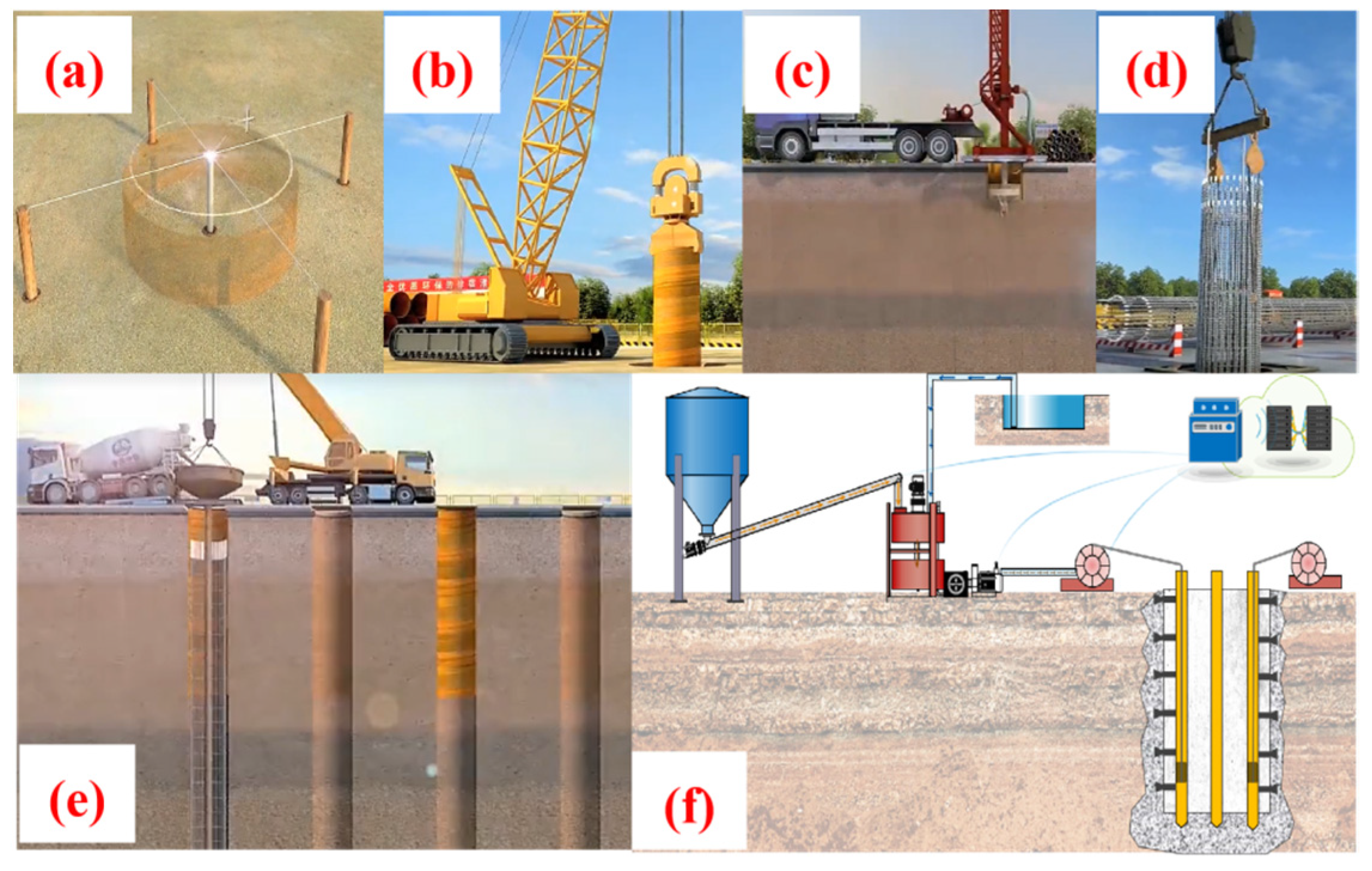






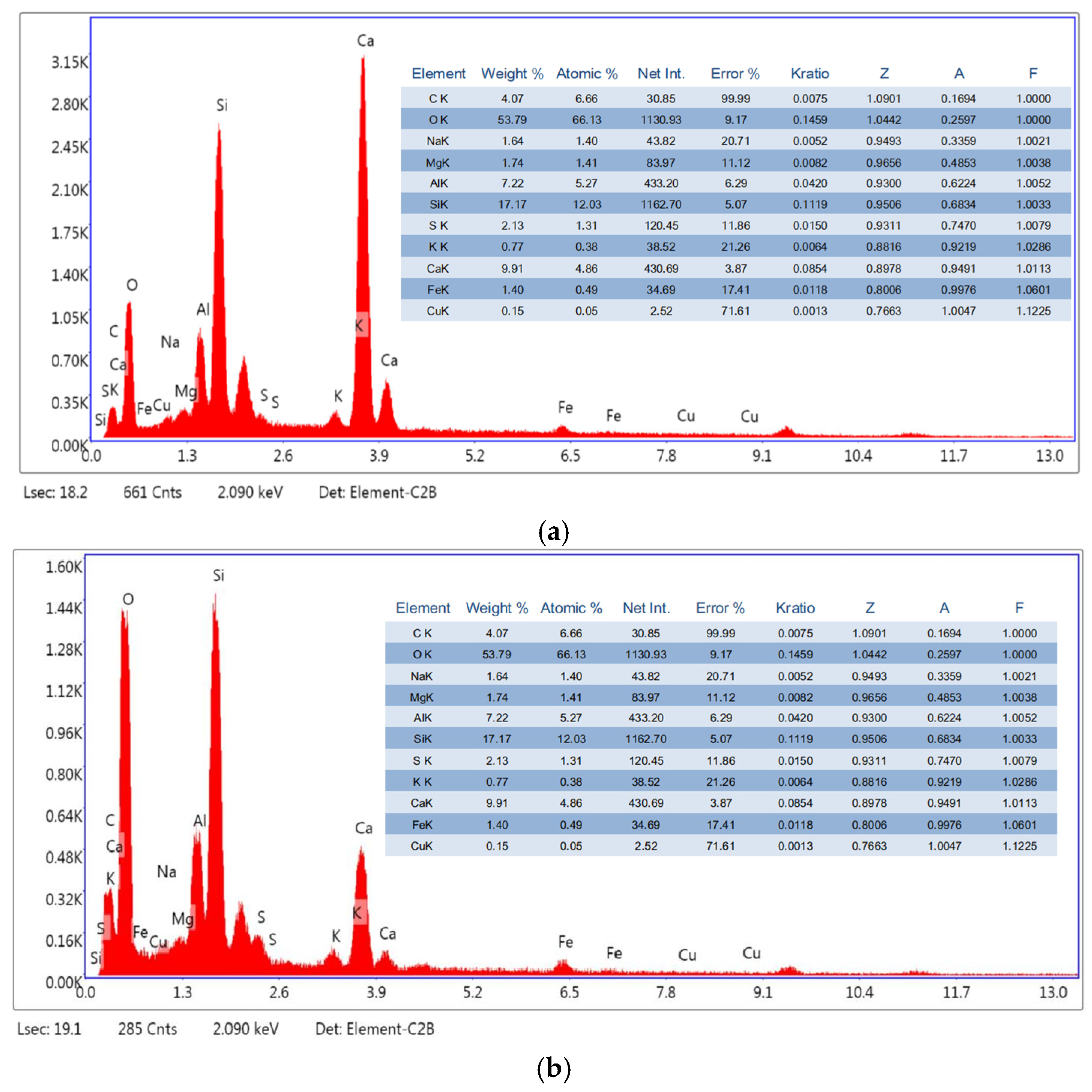
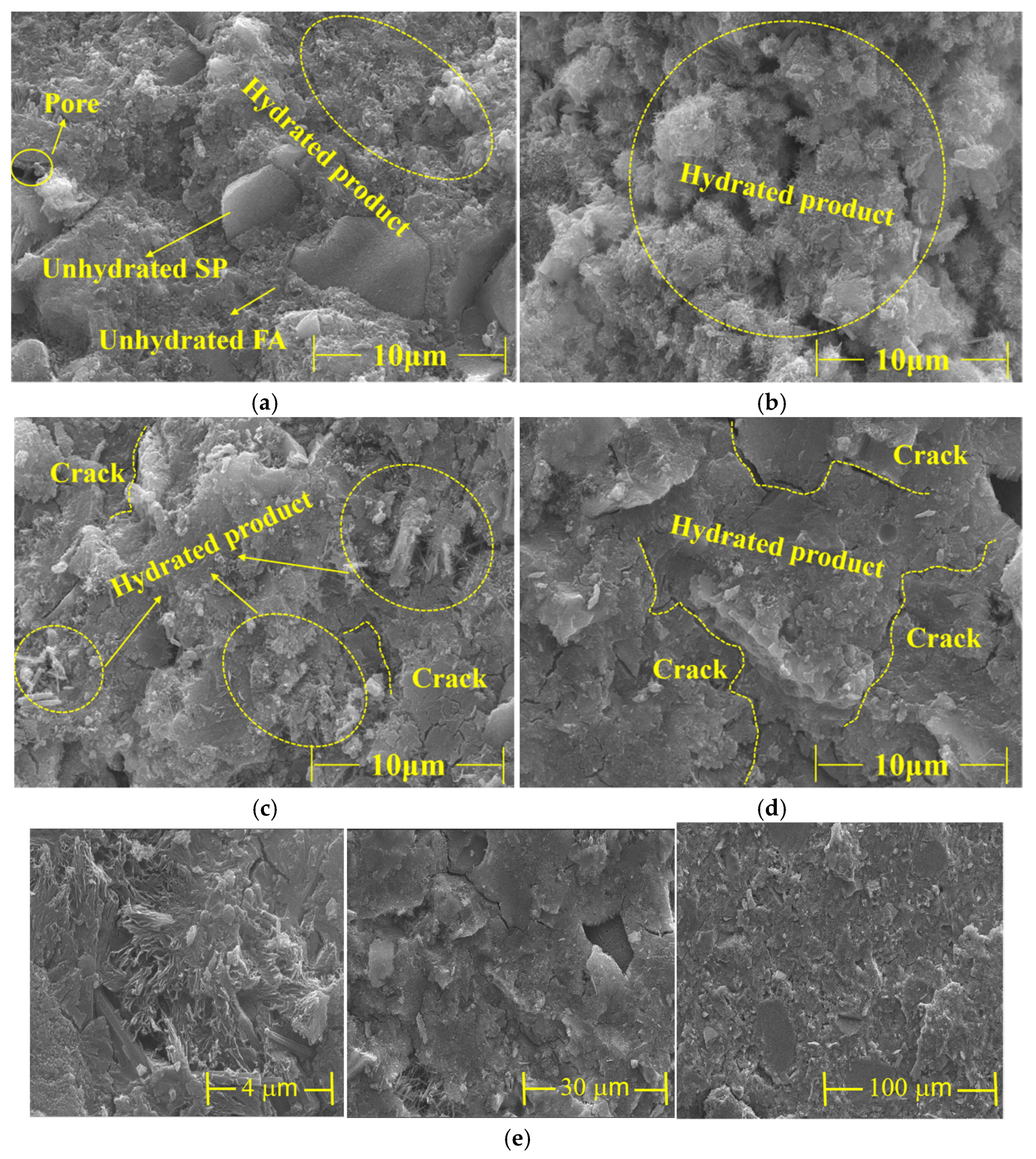

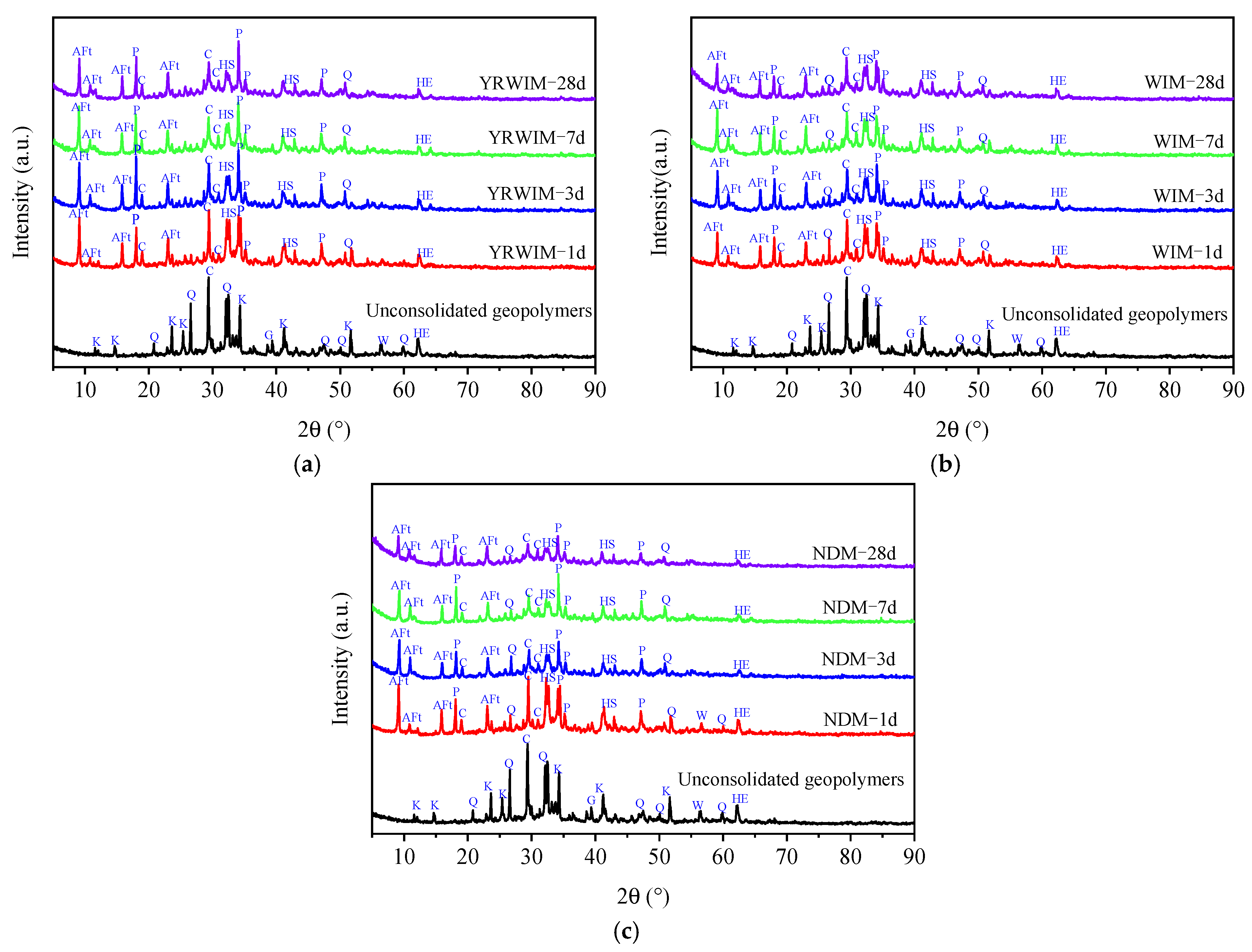
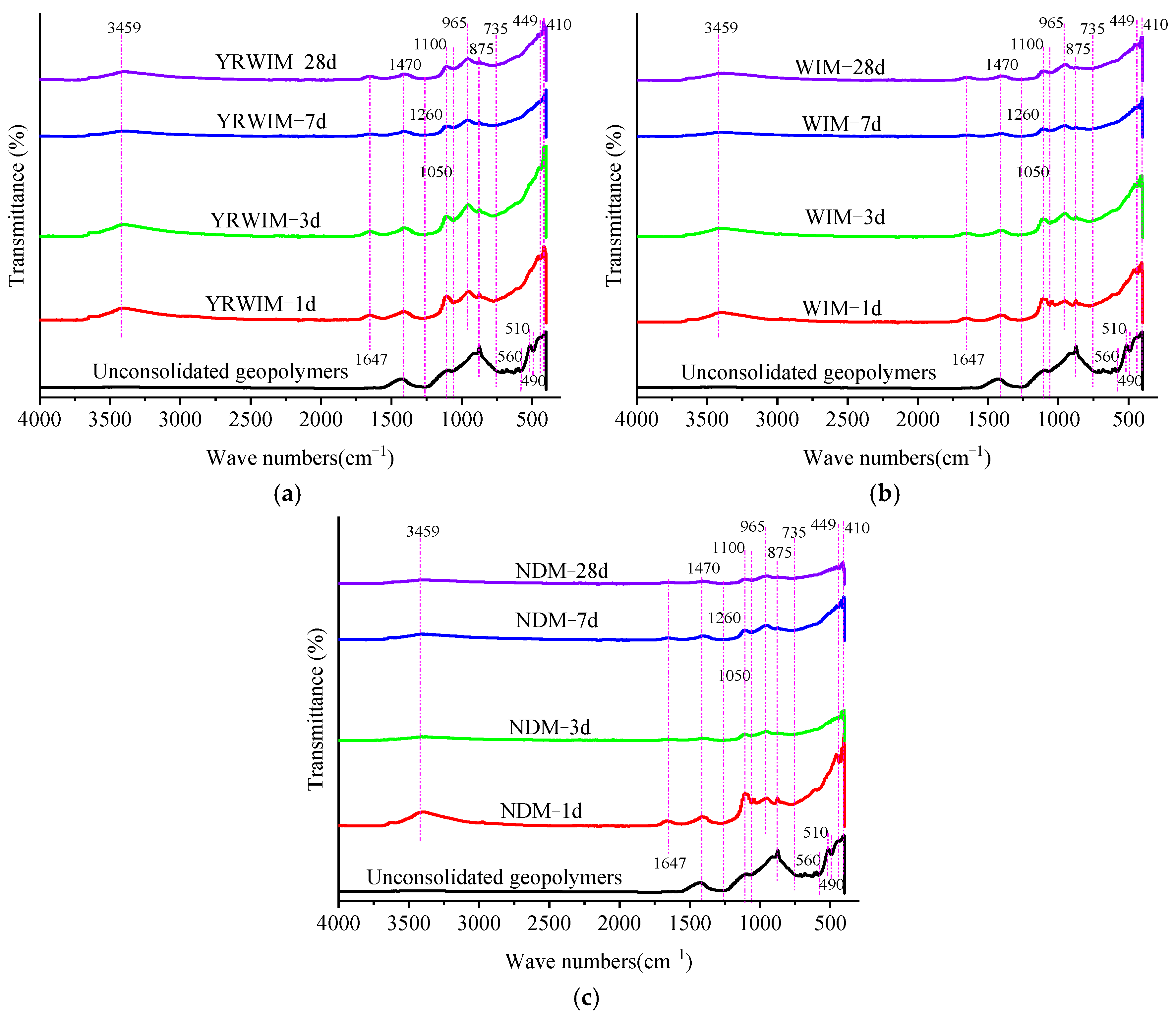
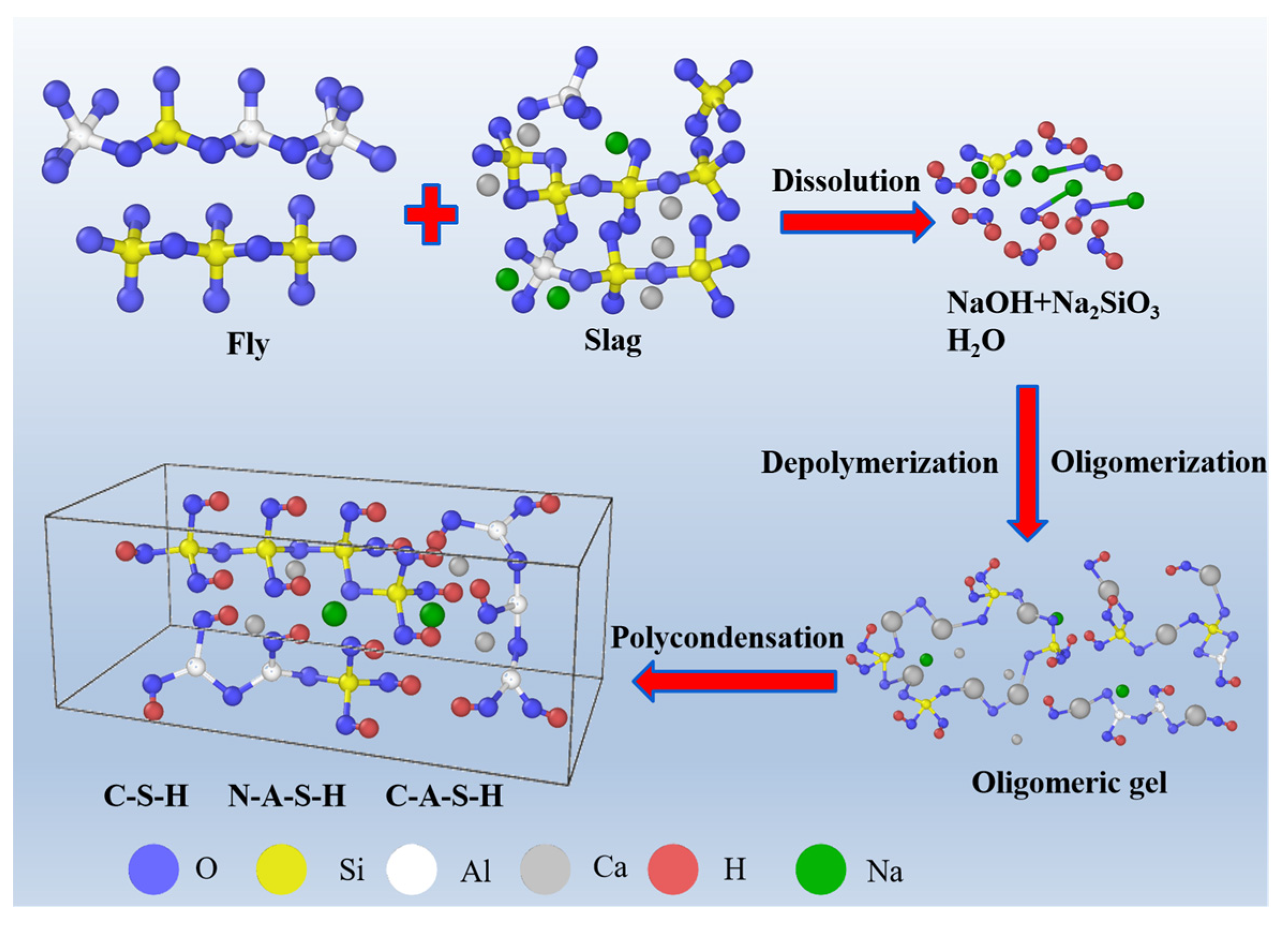
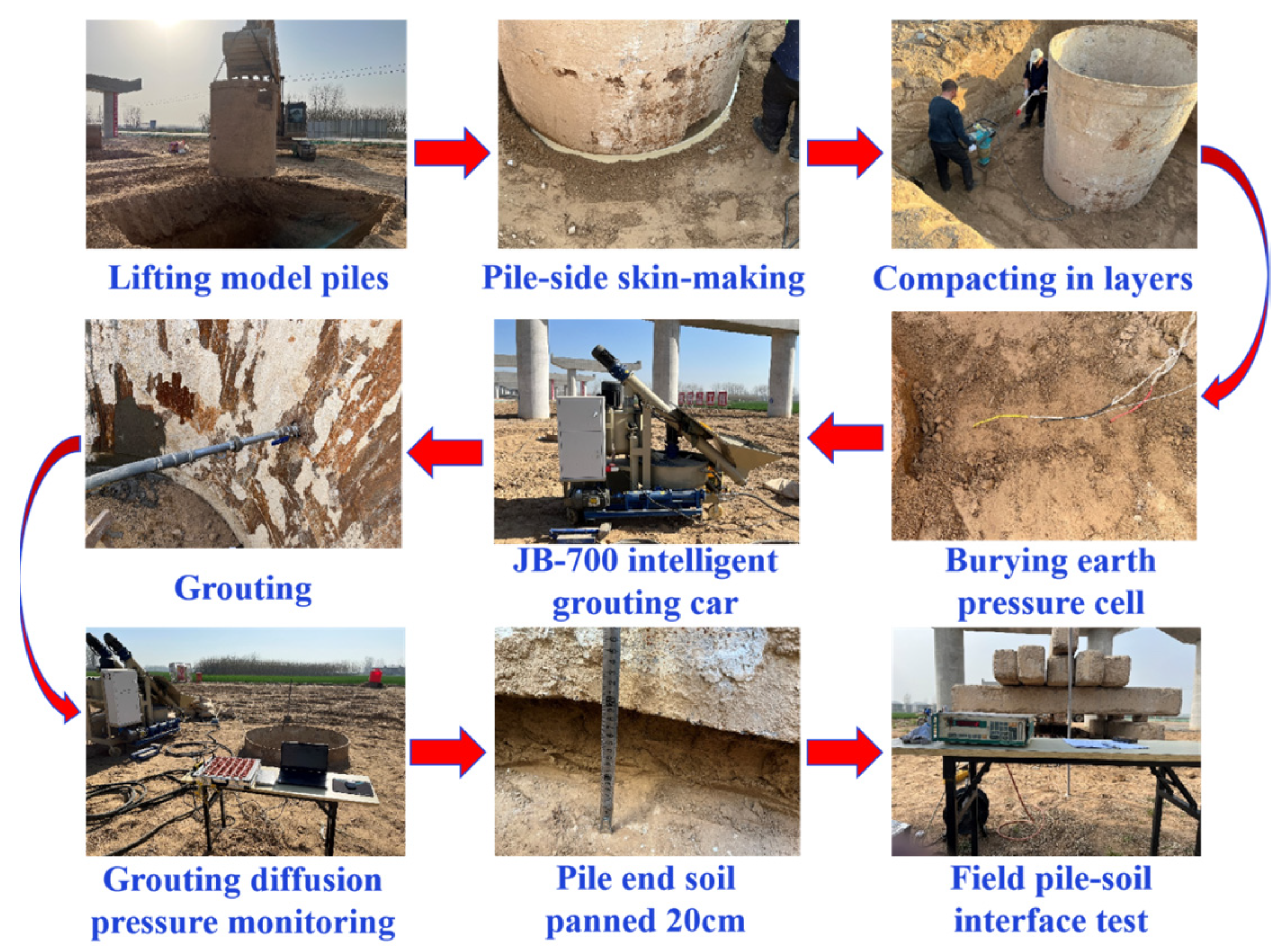
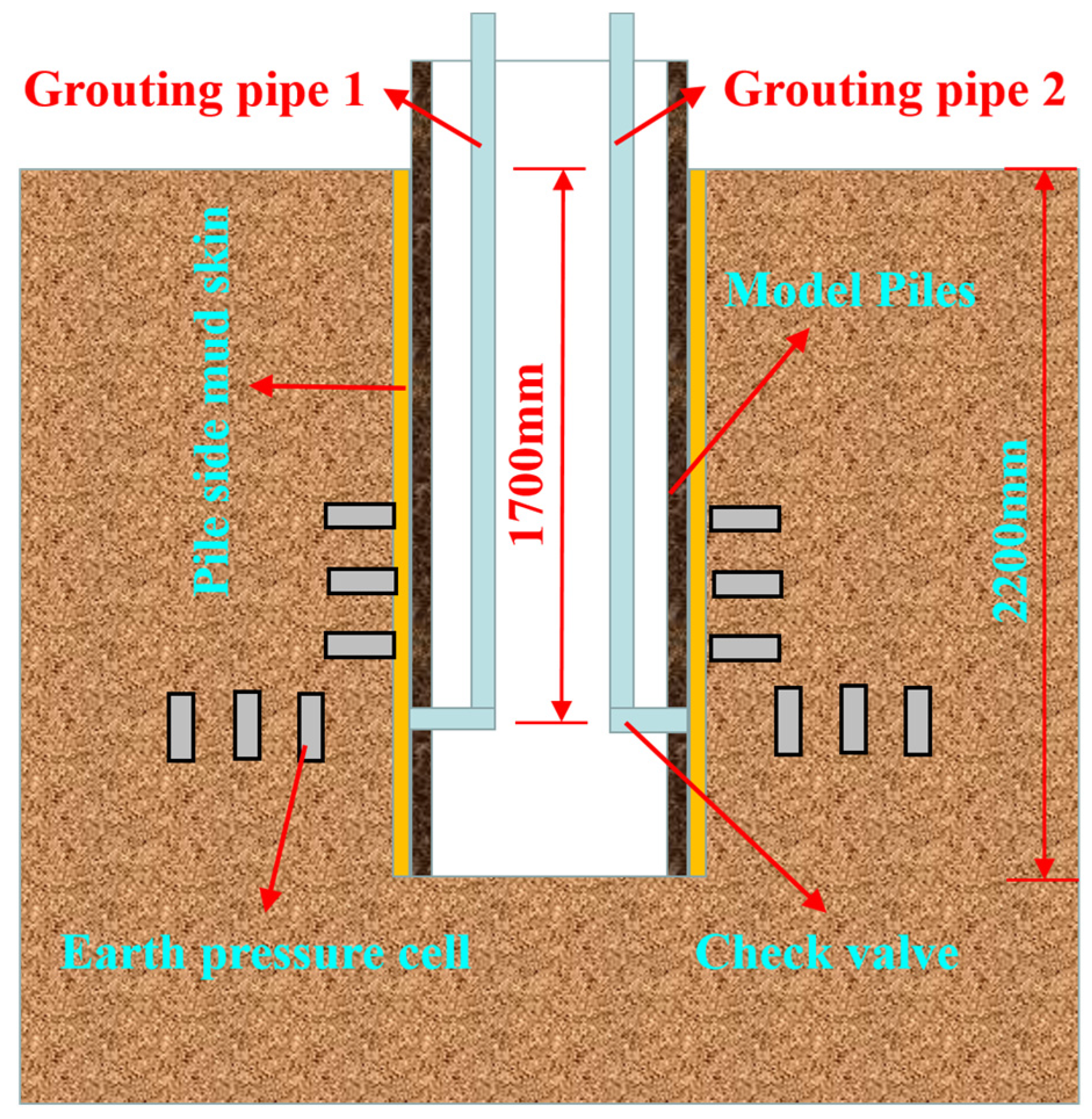

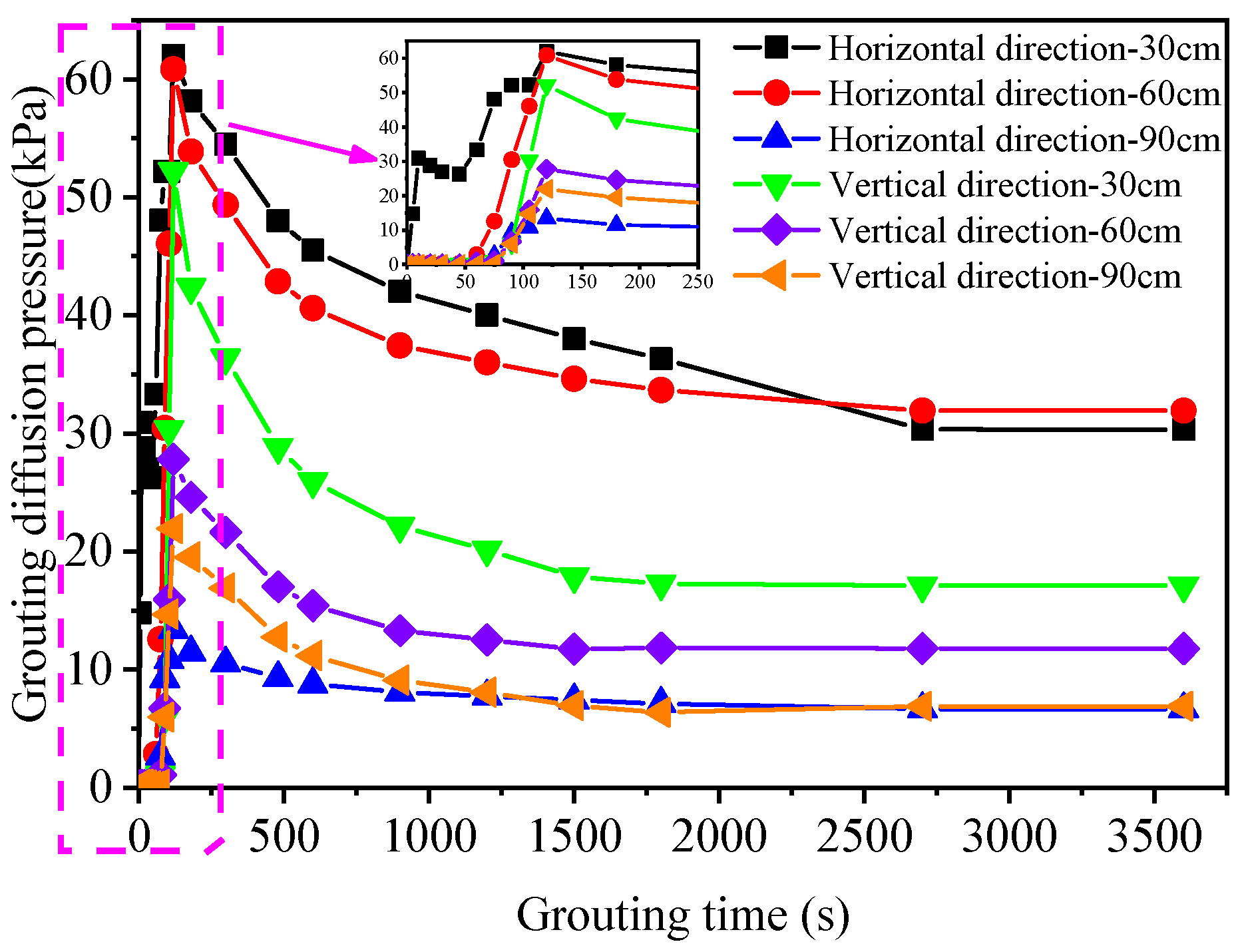

| Raw Materials | Quality Fraction (%) | |||||||||||
|---|---|---|---|---|---|---|---|---|---|---|---|---|
| SiO2 | Al2O3 | CaO | MgO | Fe2O3 | Na2O | K2O | MnO | TiO2 | P2O5 | Others | LOI | |
| FA | 56.9 | 22.1 | 7.3 | 3.6 | 4.1 | 0.8 | 0.4 | 0.11 | 1.0 | - | 3.69 | 2.45 |
| SP | 32.4 | 4.8 | 51.3 | 3.9 | 1.6 | 0.5 | 0.3 | 0.4 | 0.6 | - | 4.2 | 2.14 |
| SS | 13.21 | 4.35 | 48.78 | 4.21 | 20.63 | - | - | 3.16 | 1.83 | 1.25 | 2.58 | 1.68 |
| Types | FA (%) | SP (%) | SS (%) | NaOH (%) | Na2SiO3 (%) | L/S |
|---|---|---|---|---|---|---|
| GP-1 | 90 | 0 | 0 | 10 | 5 | 0.6 |
| GP-2 | 0 | 90 | 0 | 10 | 5 | 0.6 |
| GP-3 | 0 | 0 | 90 | 10 | 5 | 0.6 |
| GP-4 | 45 | 45 | 0 | 10 | 5 | 0.6 |
| GP-5 | 45 | 0 | 45 | 10 | 5 | 0.6 |
| GP-6 | 0 | 45 | 45 | 10 | 5 | 0.6 |
| GP-7 | 30 | 30 | 30 | 10 | 5 | 0.6 |
| Numbers | FT (s) | BR (%) | IST (min) | FST (min) | 7 d FS (MPa) | 7 d UCS (MPa) |
|---|---|---|---|---|---|---|
| GP-1 | 15.2 ± 0.4 | 0.4 ± 0.05 | 132 ± 3.7 | 293 ± 4.9 | 3.23 ± 0.18 | 10.55 ± 1.45 |
| GP-2 | 12.3 ± 0.3 | 0.2 ± 0.03 | 29 ± 2.4 | 93 ± 4.2 | 4.01 ± 0.11 | 20.94 ± 2.07 |
| GP-3 | 10.5 ± 0.3 | 0.4 ± 0.04 | 264 ± 4.9 | 383 ± 12.3 | 2.77 ± 0.15 | 12.21 ± 1.32 |
| GP-4 | 9.1 ± 0.2 | 0.1 ± 0.02 | 95 ± 4.9 | 155 ± 4.1 | 4.82 ± 0.16 | 25.51 ± 1.13 |
| GP-5 | 13.8 ± 0.5 | 0.2 ± 0.03 | 99 ± 4.1 | 156 ± 4.9 | 1.22 ± 0.21 | 10.83 ± 1.02 |
| GP-6 | 12.9 ± 0.4 | 0.3 ± 0.03 | 117 ± 4.1 | 203 ± 7.3 | 3.94 ± 0.26 | 18.11 ± 1.82 |
| GP-7 | 13.1 ± 0.5 | 0.4 ± 0.13 | 132 ± 4.9 | 293 ± 9.8 | 3.65 ± 0.32 | 15.12 ± 1.57 |
| Traditional cement-based materials | 12.1 ± 0.2 | 0.3 ± 0.02 | 245 ± 5.7 | 385 ± 10.6 | 1.39 ± 0.13 | 19.23 ± 1.63 |
| Zeng and Wang [29] | 32.35 | - | 34 | - | 1.50 | 11.84 |
| Model Pile Number | Grouting Volume (kg) |
|---|---|
| LD-1 | 0 |
| LD-2 | 100 |
| LD-3 | 150 |
| LD-4 | 200 |
| Density (g⋅cm3) | Water Content (%) | Cohesion (kPa) | Internal Friction Angle (°) | Void Ratio | Constrained Modulus (MPa) |
|---|---|---|---|---|---|
| 1.9 | 24.8 | 8.8 | 31.2 | 0.81 | 21.2 |
| Model Pile Number | Model Parameter a | Model Parameter b | Goodness of Fitting R2 |
|---|---|---|---|
| LD-1 | 0.0726 | 0.0279 | 0.9948 |
| LD-2 | 0.0360 | 0.0030 | 0.9973 |
| LD-3 | 0.0288 | 0.0029 | 0.9980 |
| LD-4 | 0.0195 | 0.0029 | 0.9988 |
Disclaimer/Publisher’s Note: The statements, opinions and data contained in all publications are solely those of the individual author(s) and contributor(s) and not of MDPI and/or the editor(s). MDPI and/or the editor(s) disclaim responsibility for any injury to people or property resulting from any ideas, methods, instructions or products referred to in the content. |
© 2025 by the authors. Licensee MDPI, Basel, Switzerland. This article is an open access article distributed under the terms and conditions of the Creative Commons Attribution (CC BY) license (https://creativecommons.org/licenses/by/4.0/).
Share and Cite
He, C.; Xu, Z.; Wang, J.; Li, P.; Xia, Y.; Zhang, C.; Chen, Z.; He, W. Performance Optimization and Field Validation of Post-Grouting Geopolymer Materials for Pile Foundations: Microstructural Insights and Environmental Durability. Buildings 2025, 15, 1121. https://doi.org/10.3390/buildings15071121
He C, Xu Z, Wang J, Li P, Xia Y, Zhang C, Chen Z, He W. Performance Optimization and Field Validation of Post-Grouting Geopolymer Materials for Pile Foundations: Microstructural Insights and Environmental Durability. Buildings. 2025; 15(7):1121. https://doi.org/10.3390/buildings15071121
Chicago/Turabian StyleHe, Chongchong, Zhen Xu, Jing Wang, Pan Li, Yangyang Xia, Chao Zhang, Zhenpeng Chen, and Wei He. 2025. "Performance Optimization and Field Validation of Post-Grouting Geopolymer Materials for Pile Foundations: Microstructural Insights and Environmental Durability" Buildings 15, no. 7: 1121. https://doi.org/10.3390/buildings15071121
APA StyleHe, C., Xu, Z., Wang, J., Li, P., Xia, Y., Zhang, C., Chen, Z., & He, W. (2025). Performance Optimization and Field Validation of Post-Grouting Geopolymer Materials for Pile Foundations: Microstructural Insights and Environmental Durability. Buildings, 15(7), 1121. https://doi.org/10.3390/buildings15071121






